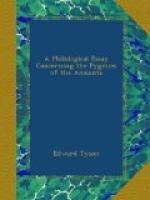The Innuit or Eskimo were called by the original Norse explorers “Skraelingjar,” or dwarfs, a name now converted by the Innuit into “karalit,” which is the nearest approach that they are able to make phonetically to the former term. They are certainly, on the average, a people of less than middle stature, yet they can in no sense be described as Pigmies. Their mean height is five feet three inches. Nansen[A] says of them, “It is a common error amongst us in Europe to think of the Eskimo as a diminutive race. Though no doubt smaller than the Scandinavian peoples, they must be reckoned amongst the middle-sized races, and I even found amongst those of purest breeding men of nearly six feet in height.”
[Footnote A: Eskimo Life, p. 20.]
II.
The raison d’etre of Tyson’s essay was to explain away the accounts of the older writers relating to Pigmy races, on the ground that, as no such races existed, an explanation of some kind was necessary in order to account for so many and such detailed descriptions as were to be found in their works. Having now seen not merely that there are such things as Pigmy races, but that they have a wide distribution throughout the world, it may be well to consider to which of the existing or extinct races, the above-mentioned accounts may be supposed to have referred. In this task I am much aided in several instances by the labours of De Quatrefages, and as his book is easily accessible, it will be unnecessary for me to repeat the arguments in favour of his decisions which he has there given.
Starting with Asia, we have in the first place the statement of Pliny, that “immediately after the nation of the Prusians, in the mountains where it is said are pigmies, is found the Indus.” These Pigmies may be identified with the Brahouis, now Dravidian, but still possessing the habit, attributed to them by Pliny, of changing their dwellings twice a year, in summer and winter, migrations rendered necessary by the search for food for their flocks. The same author’s allusion to the “Spithamaei Pygmaei” of the mountains in the neighbourhood of the Ganges may apply to the Santals or some allied tribe, though Pliny’s stature for them of two feet four inches is exaggeratedly diminutive, and he has confused them with Homer’s Pigmies, who were, as will be seen, a totally different people.
Ctesias[A] tells us that “Middle India has black men, who are called Pygmies, using the same language as the other Indians; they are, however, very little; that the greatest do not exceed the height of two cubits, and the most part only of one cubit and a half. But they nourish the longest hair, hanging down unto the knees, and even below; moreover, they carry a beard more at length than any other men; but, what is more, after this promised beard is risen to them, they never after use any clothing, but send down, truly, the hairs from the back much below the knees,




